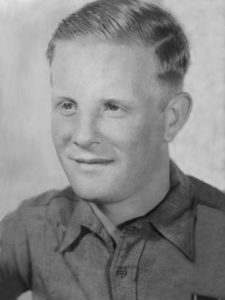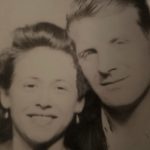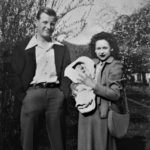Ranger Richard L Foley

Richard L Foley
Born: 11 June 1924 Fred, West Virginia
Died: 20 October 2001 Mims, Florida at age 77
Army Serial Number: 3565360
Ranger Battalion/Company: 5/A
Rank: PFC
Enlisted: 10 March 1943 at Ft Thomas, Newport, Kentucky
Battles/Campaigns/Significants: D Day Normandy Invasion/ Maisy Battery/ Brittanny Campaign
Medals/Awards: Combat Infantryman Badge/ Bronze Star Medal/ EAME Campaign Medal/ Purple Heart Medal with OLC/ WWII Victory Medal/ Presidential Unit Citation
Biography
Richard L Foley was born 11 June 1924 in Fred, West Virginia. He was the son of Richard Bell Foley and Lilly Belle Burgess. Richard Bell Foley supported his very large family in the coal mining industry as a blacksmith. He also worked in the WPA (Work Program Administration) projects working on the roads in 1940. Richard also was working in the coal mines in Becco, West Virginia in 1942. He filled out a draft card on 30 June 1942 while he was coal mining. His description on the card: 5”10”, 149 Lbs., blue eyes and brown hair.
Richard was inducted into the Army and signed up on 8 March 1943 at Fort Thomas in Newport, Kentucky. When he volunteered to train as a 5th Ranger he was stationed at Camp Butner, North Carolina. He was transferred to the 5th Rangers from Company D 311th Infantry Regiment in the 78th Infantry Division (Lightning Division) on 16 September 1943. He was sent to Camp Forrest, Tennessee to begin rigorous Ranger training. I’d like to note that Ranger Foley’s Army buddy Hubert “Hap” Putney also came from 311th infantry Regt. 78th Inf. Div. Hap was in K Company.
The 5th Ranger volunteers numbered about 3,000 men. Men were interviewed and evaluated. By the 21st of September 1943 they had weeded out men that couldn’t make the cut. They had 34 officers and 503 enlisted men. The training at Camp Forrest continued to toughen the Rangers for the upcoming war engagements. Ranger Foley like the other men would arise at 5 am, fall out for roll call, return to barracks to make beds and at 6 am eat breakfast. After breakfast he would have returned to the barracks to get his gear. At 8 am the Rangers assembled by company and marched to the physical training area for an hour of training. Next there would be an hour of hand to hand combat maneuvers. Until lunch they participated in squad tactics. After lunch there were lectures, films, getting familiar with all the weapons, etc. 3 pm the men wearing field packs and sidearms went on a fast road march of 7 miles. They were eventually able to complete the 7 mile marches in one hour. Two weeks into training an obstacle course replaced the physical training. This course required men to climb walls, run across rope bridges, traverse hand over hand on a rope over water with live explosives going off below, walk across logs, climb cargo nets, climb hand over hand up a rope and run to the end of the course. All of this was done while live ammo was going off around them. They learned to navigate with a compass, become experts reading maps and had expeditions to find their way back to camp. By the end if you didn’t wash out there was a sense of pride from this intense conditioning.
After almost 2 months at Camp Forrest, the Rangers left and took a train headed to Ft Pierce in Florida. They traveled by rail almost 800 miles and arrived at the Fort on 5 November 1943. Fort Pierce was a combination Army/Navy training base specializing in Amphibious Scout and Raider Training.
Training at Fort Pierce consisted of handling small rubber crafts and the various other watercraft the men would have to use. A form of Jiu Jitsu was taught to the men as part of their physical conditioning. The last exercise the Rangers were assigned was to assault both Fort Pierce and the town itself. It was a big success and the 5th Rangers were the only unit that had been able to completely capture both the town and Fort.
On November 19th the 5th Rangers boarded a train for a 560 mile ride to Columbia, South Carolina. They changed trains and had another 558 mile ride to Ft Dix, New Jersey. They officially arrived on November 20th. After about a week of duty groups of men were granted 5 day furloughs. Many of the Rangers were issued promotions. Ranger Foley was promoted to Private First Class on the 16th of December 1943.
December 20th 1943 the Rangers boarded another train headed for Camp Kilmer, New Jersey. Several weeks later they were transported to New York Harbor and boarded the HMS Mauretania on 7 January 1944 but they collided with a freighter in the harbor and returned to port for repairs. A day later they were heading for the long trip to Liverpool, England Harbor. After a week at sea with many seasick Rangers they came into the harbor on the 18th of January. They were moved from Liverpool to Leominister, England. The men were billeted in private homes in Leominister. On the 26th of February Ranger Foley was detached and sent to an English hospital. He returned to the Rangers on April 6th from 10th Replacement Depot. The Rangers were stationed at Braunton, England. During March the Rangers trained with the Commandos in Scotland. Richard was at the hospital and then finally got back to his unit. By 27 April the men were in Dorchester when alerted for departure for operation Fabius One. The Rangers of 2nd Battalion and 5th Battalion would work together to land and do operations as a mock up of D Day. It was the biggest practice assault ever done with many units involved. The Rangers had a successful operation and they went back to wait for the D Day Operation. They were in Swanage, England until moving back to Dorchester on the 17th of May. The men moved to Weymouth, England on 1 June 1944. They boarded the HMS Prince Leopold. They stayed on the ship and on June 6th headed for the assault on Normandy.
Many stories have been written about experiences on D Day. The 5th Rangers were fortunate to have a seasoned former 1st Ranger, Max Schneider at the helm. Coming in towards the beach he observed the best location to land and directed his men to observe that location and then keep your heads down. He directed the Coxswain to turn the LCA to the left where Schneider observed there was less German fire. There were obstacles in the water to get past coming in and carrying 100 lbs of gear didn’t help. Ace Parker and part of A company made the landing with no casualties and made it to the first contact point.
Ranger Foley survived the turmoil of D Day and he was part of A company with Ace Parker as his commander that invaded the stronghold of Maisy Battery which had large guns to protect a sea invasion and a stronghold of men, ammunition and supplies. It was a challenge because the Battery had an intense web of mines on one side that if one was activated 10 bouncing Bettys would go off. The other area was flooded by seawater and men had to wade into attack. The Battery had been bombed to soften the Germans prior to the attack by 3 companies of 5th Rangers. After about 5 hours of combat the Germans were defeated. Hap Putney and a few other A Company men were seriously wounded.
The next day the Rangers were in a Bivouac outside of Ormansville, France. Patrols were sent out to find and take German prisoners. On that evening a German Bomber overhead dropped bombs in the Ranger camp. It is not specific how Ranger Foley and Ranger Seaman were seriously wounded on 10 June 1944. It may have been from shrapnel from the bomb blast or wounded while out on a patrol. There were men that were killed by the bomb blast. Both Foley and Seaman were evacuated to a hospital. Ranger Foley must have had serious injuries because he did not return to the A Co 5th Rangers from Headquarters of the 38th Replacement Depot until 22 November 1944. His MOS(Military Occupational Specialty) was 504 which was an ammunition handler. When he returned to duty he had an MOS of 745 which was a rifleman.
Ranger Foley came back into the Rangers as they were moving across France and into Germany. The 5th Rangers became a part of General Patton’s 3rd Army and were attached to the 6th Cavalry Group. A cavalry unit consisted of light tanks and armored cars. The 5th Rangers took over their line. Their job was to keep track of what the Germans were doing and act as a blocking agent. This was shortly before the Battle of the Bulge.
The assignment took place in an area called Ludweiler, Germany. F Company was ordered to cross an open field to reach a group of houses during the daylight hours to take the town of Lauterbach, Germany. F Company was trapped in an open field under heavy enemy fire. They were calling for help and reinforcement, that was on December 3 1944. Ace Parker and his A Company men including Ranger Foley were ordered to give them backup. Ace accessed the situation and said he would prefer to attempt it after dark thinking of the safety of his men. They moved in the darkness of night to assist F Company and were able to moved thru the field and into a cluster of houses. They took shelter in the basement of one of the buildings The Germans had machine gun nests set up in the area and Ace accessed the situation and called in some artillery to occupy the Germans while they escaped to the woods. Ranger Foley and 13 other A Company men were sent out to recuperate on 6 December after this ordeal. Ranger Foley returned to duty 4 days later. They were still at Ludweiler, Germany when on 5 January 1945 Richard was sent to the 320th Medical Battalion as a Line of Duty Casualty. 2 days later Foley was evacuated to the 34th Evac Hospital and he was dropped from his Ranger assignment.
Richard was released from the hospital and was told he was not fit for combat anymore. He thought he was going home but was sent to the 425th Night Fighter Squadron of the 9th Air Force. The Squadron went from Frankfort, Germany and moved on to Nuremberg Air Base in Germany. He was a high pointer meaning he was soon due to go home because of his ASR Score. He was sent to La Havre, France and assigned to the 393rd Fighter Squadron. On 1 September 1945 He left La Havre, France and sailed in to Staten Island, New York and arrived on 12 September 1945. He was transported to Camp Kilmer, New Jersey and then on to Fort Meade, Maryland and was honorably discharged in October 1945 from the Air Force.
Richard returned to West Virginia and worked for many years in the coal mines like his father did. In 1949 He fell in love and married Naomi Pearl Burress in Crawley, West Virginia. They were married for 52 years. The Foleys raised 6 sons and one daughter. After retiring from coal mining he and Naomi relocated to Florida. Richard was a charter member of The Victory Free Will Baptist Church. He was also a Minister and started his own First Free Will Baptist Church in Scottsmoor, Florida. Richard became interested in looking up an 5th Ranger buddy Hap Putney. The last time he had talked to Hap was in 1946. He and Hap kept in contact and Hap informed him about the Ranger Reunions. One of Richard and Naomi’s sons took them to visit Hap and his family.
Reverend Richard Foley died after a six week illness on 20 October 2001 at Wustoff Hospital at Rockledge, Florida. He died at the age of 77. He was honored with Military Rites. His wife Naomi died in 2016. They were both laid to rest at Forest Lawn Cemetery in Pecks Mill, Florida.

